Business Law Report: Contract and Negligence Analysis
VerifiedAdded on 2019/12/28
|11
|3897
|177
Report
AI Summary
This report delves into the core principles of contract law and negligence within a business context. It begins by defining contracts, outlining essential elements such as offer and acceptance, consideration, and competency of parties, and then explores different types of contracts, including face-to-face, verbal, written, bilateral, and unilateral agreements. The report then examines contractual terms, differentiating between expressed and implied terms and their implications. The analysis is applied to a case scenario involving a defective product, evaluating the applicability of contractual elements and terms, and the remedies available to the affected party. Furthermore, the report contrasts contractual liability with tort liability, specifically negligence, explaining the nature of liability in negligence, vicarious liability, and the elements of the tort of negligence. The report concludes by synthesizing these legal concepts and their practical implications for businesses, using the case scenario to illustrate the application of legal principles and the potential liabilities involved.
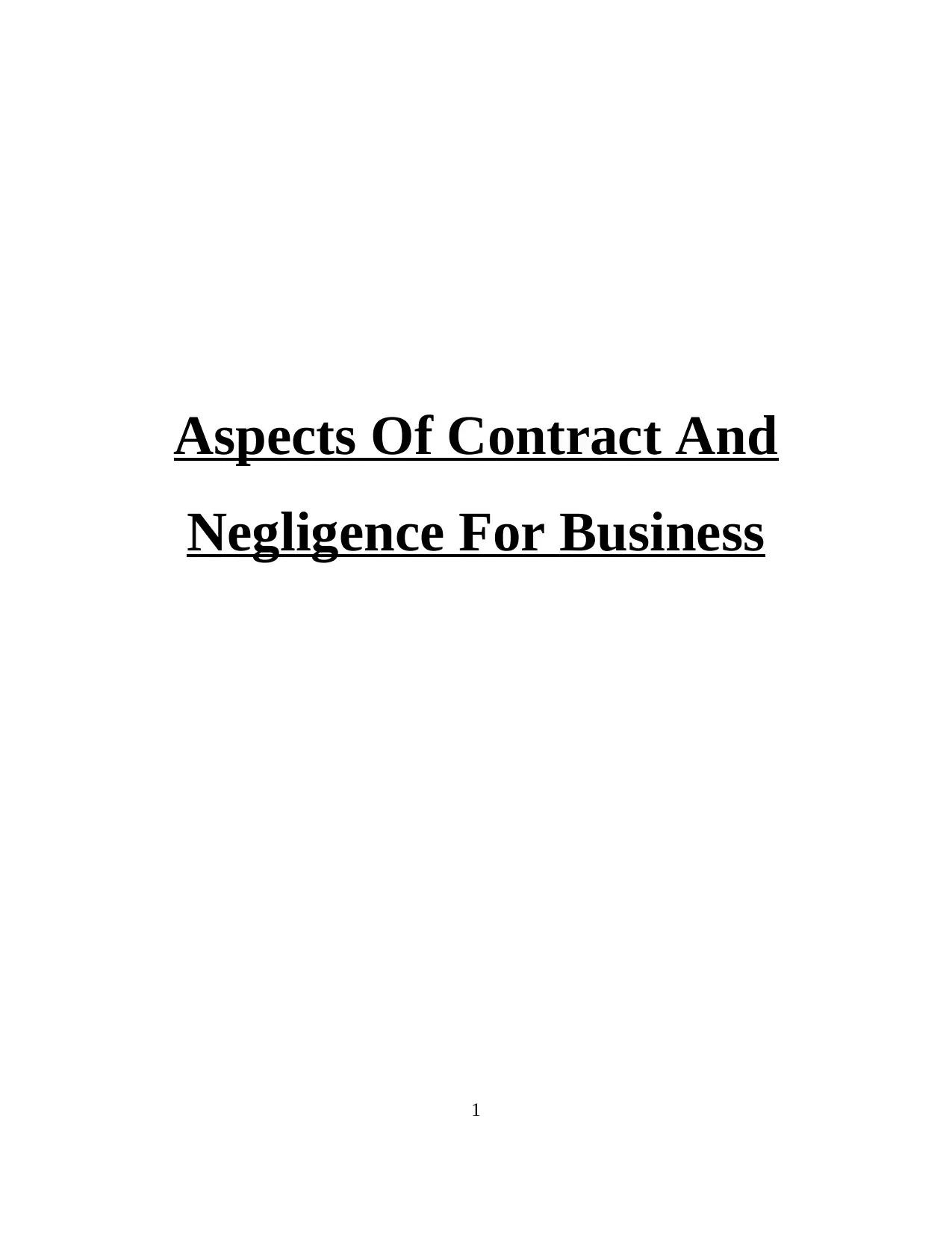
Aspects Of Contract And
Negligence For Business
1
Negligence For Business
1
Paraphrase This Document
Need a fresh take? Get an instant paraphrase of this document with our AI Paraphraser
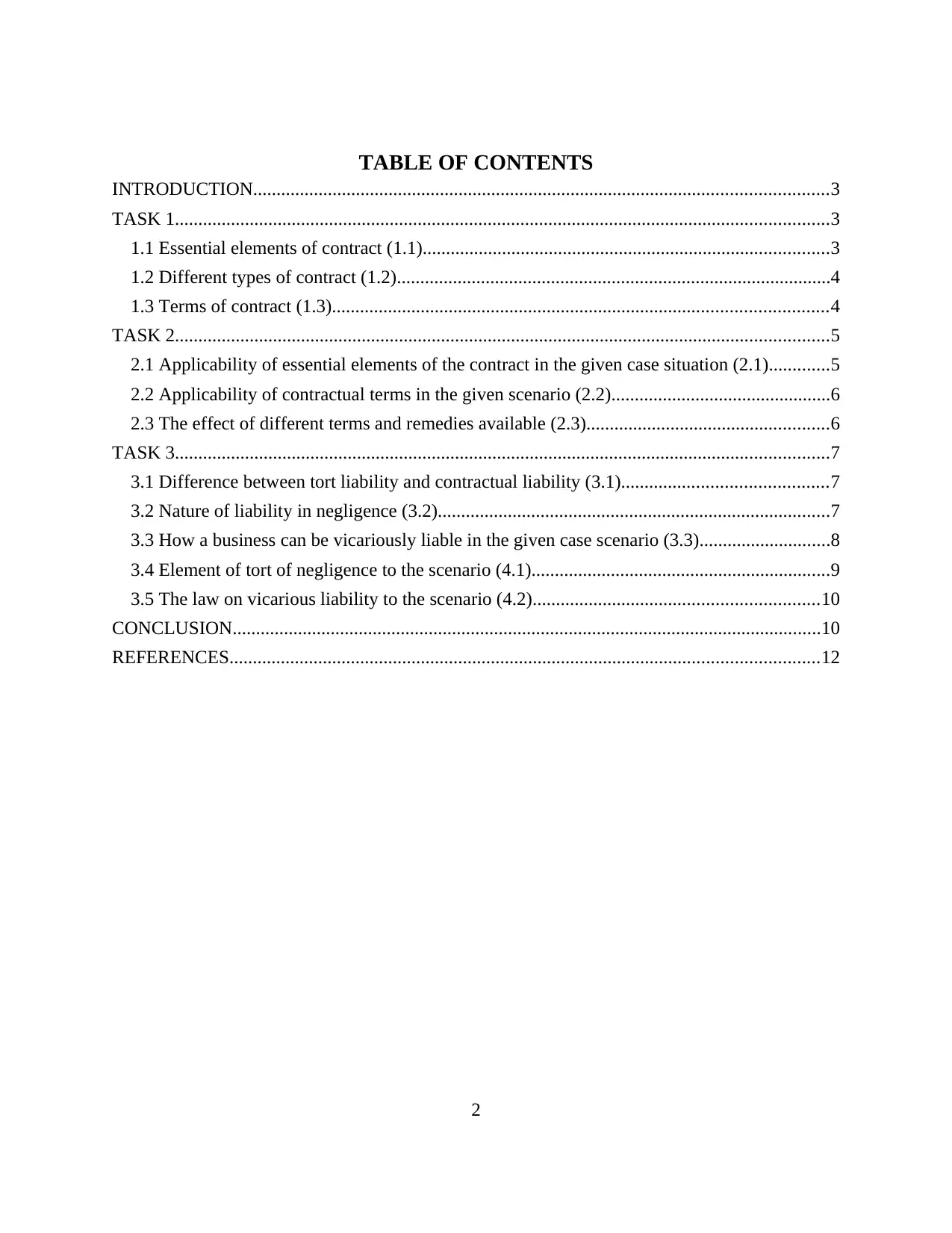
TABLE OF CONTENTS
INTRODUCTION...........................................................................................................................3
TASK 1............................................................................................................................................3
1.1 Essential elements of contract (1.1).......................................................................................3
1.2 Different types of contract (1.2).............................................................................................4
1.3 Terms of contract (1.3)..........................................................................................................4
TASK 2............................................................................................................................................5
2.1 Applicability of essential elements of the contract in the given case situation (2.1).............5
2.2 Applicability of contractual terms in the given scenario (2.2)...............................................6
2.3 The effect of different terms and remedies available (2.3)....................................................6
TASK 3............................................................................................................................................7
3.1 Difference between tort liability and contractual liability (3.1)............................................7
3.2 Nature of liability in negligence (3.2)....................................................................................7
3.3 How a business can be vicariously liable in the given case scenario (3.3)............................8
3.4 Element of tort of negligence to the scenario (4.1)................................................................9
3.5 The law on vicarious liability to the scenario (4.2).............................................................10
CONCLUSION..............................................................................................................................10
REFERENCES..............................................................................................................................12
2
INTRODUCTION...........................................................................................................................3
TASK 1............................................................................................................................................3
1.1 Essential elements of contract (1.1).......................................................................................3
1.2 Different types of contract (1.2).............................................................................................4
1.3 Terms of contract (1.3)..........................................................................................................4
TASK 2............................................................................................................................................5
2.1 Applicability of essential elements of the contract in the given case situation (2.1).............5
2.2 Applicability of contractual terms in the given scenario (2.2)...............................................6
2.3 The effect of different terms and remedies available (2.3)....................................................6
TASK 3............................................................................................................................................7
3.1 Difference between tort liability and contractual liability (3.1)............................................7
3.2 Nature of liability in negligence (3.2)....................................................................................7
3.3 How a business can be vicariously liable in the given case scenario (3.3)............................8
3.4 Element of tort of negligence to the scenario (4.1)................................................................9
3.5 The law on vicarious liability to the scenario (4.2).............................................................10
CONCLUSION..............................................................................................................................10
REFERENCES..............................................................................................................................12
2
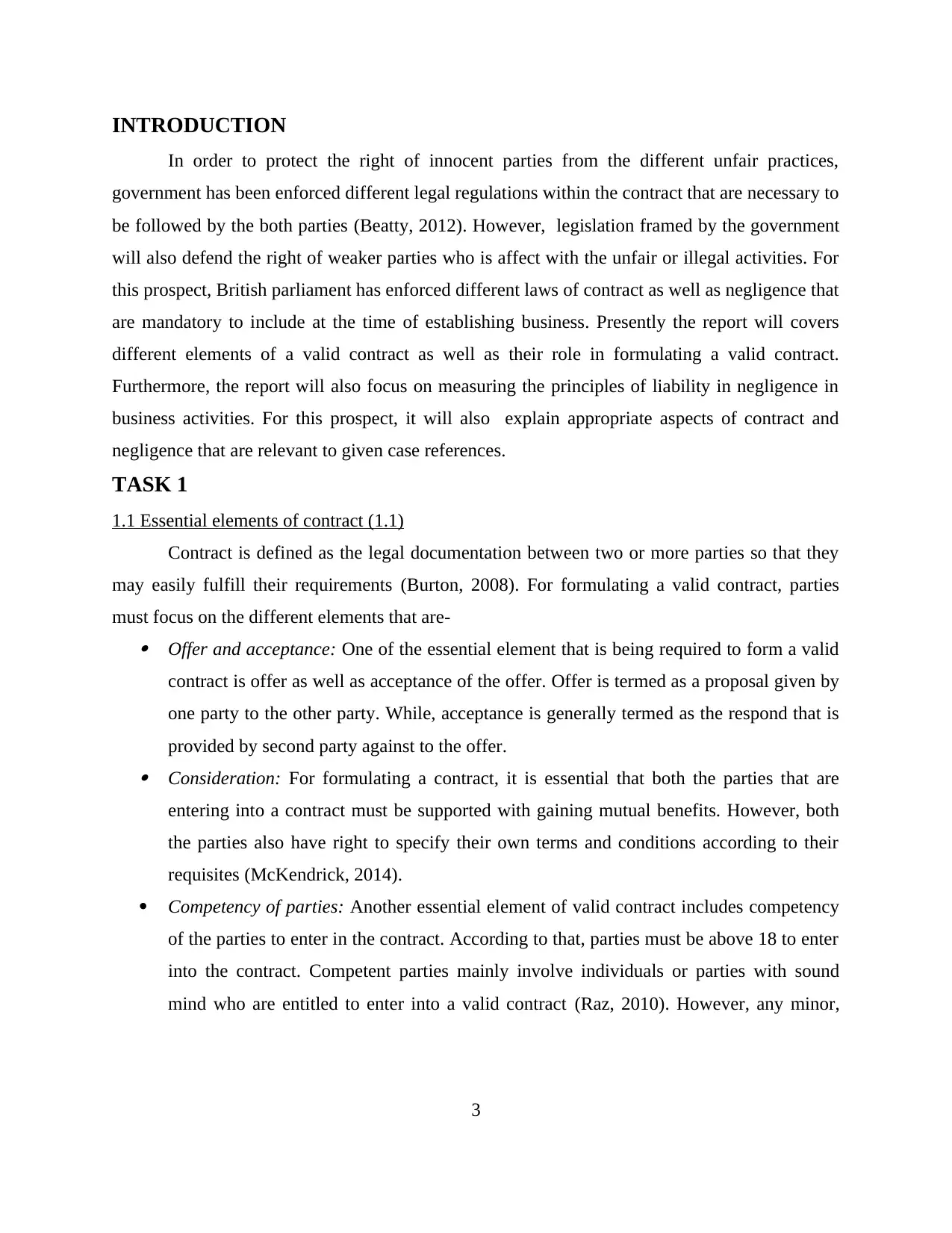
INTRODUCTION
In order to protect the right of innocent parties from the different unfair practices,
government has been enforced different legal regulations within the contract that are necessary to
be followed by the both parties (Beatty, 2012). However, legislation framed by the government
will also defend the right of weaker parties who is affect with the unfair or illegal activities. For
this prospect, British parliament has enforced different laws of contract as well as negligence that
are mandatory to include at the time of establishing business. Presently the report will covers
different elements of a valid contract as well as their role in formulating a valid contract.
Furthermore, the report will also focus on measuring the principles of liability in negligence in
business activities. For this prospect, it will also explain appropriate aspects of contract and
negligence that are relevant to given case references.
TASK 1
1.1 Essential elements of contract (1.1)
Contract is defined as the legal documentation between two or more parties so that they
may easily fulfill their requirements (Burton, 2008). For formulating a valid contract, parties
must focus on the different elements that are- Offer and acceptance: One of the essential element that is being required to form a valid
contract is offer as well as acceptance of the offer. Offer is termed as a proposal given by
one party to the other party. While, acceptance is generally termed as the respond that is
provided by second party against to the offer. Consideration: For formulating a contract, it is essential that both the parties that are
entering into a contract must be supported with gaining mutual benefits. However, both
the parties also have right to specify their own terms and conditions according to their
requisites (McKendrick, 2014).
Competency of parties: Another essential element of valid contract includes competency
of the parties to enter in the contract. According to that, parties must be above 18 to enter
into the contract. Competent parties mainly involve individuals or parties with sound
mind who are entitled to enter into a valid contract (Raz, 2010). However, any minor,
3
In order to protect the right of innocent parties from the different unfair practices,
government has been enforced different legal regulations within the contract that are necessary to
be followed by the both parties (Beatty, 2012). However, legislation framed by the government
will also defend the right of weaker parties who is affect with the unfair or illegal activities. For
this prospect, British parliament has enforced different laws of contract as well as negligence that
are mandatory to include at the time of establishing business. Presently the report will covers
different elements of a valid contract as well as their role in formulating a valid contract.
Furthermore, the report will also focus on measuring the principles of liability in negligence in
business activities. For this prospect, it will also explain appropriate aspects of contract and
negligence that are relevant to given case references.
TASK 1
1.1 Essential elements of contract (1.1)
Contract is defined as the legal documentation between two or more parties so that they
may easily fulfill their requirements (Burton, 2008). For formulating a valid contract, parties
must focus on the different elements that are- Offer and acceptance: One of the essential element that is being required to form a valid
contract is offer as well as acceptance of the offer. Offer is termed as a proposal given by
one party to the other party. While, acceptance is generally termed as the respond that is
provided by second party against to the offer. Consideration: For formulating a contract, it is essential that both the parties that are
entering into a contract must be supported with gaining mutual benefits. However, both
the parties also have right to specify their own terms and conditions according to their
requisites (McKendrick, 2014).
Competency of parties: Another essential element of valid contract includes competency
of the parties to enter in the contract. According to that, parties must be above 18 to enter
into the contract. Competent parties mainly involve individuals or parties with sound
mind who are entitled to enter into a valid contract (Raz, 2010). However, any minor,
3
⊘ This is a preview!⊘
Do you want full access?
Subscribe today to unlock all pages.

Trusted by 1+ million students worldwide
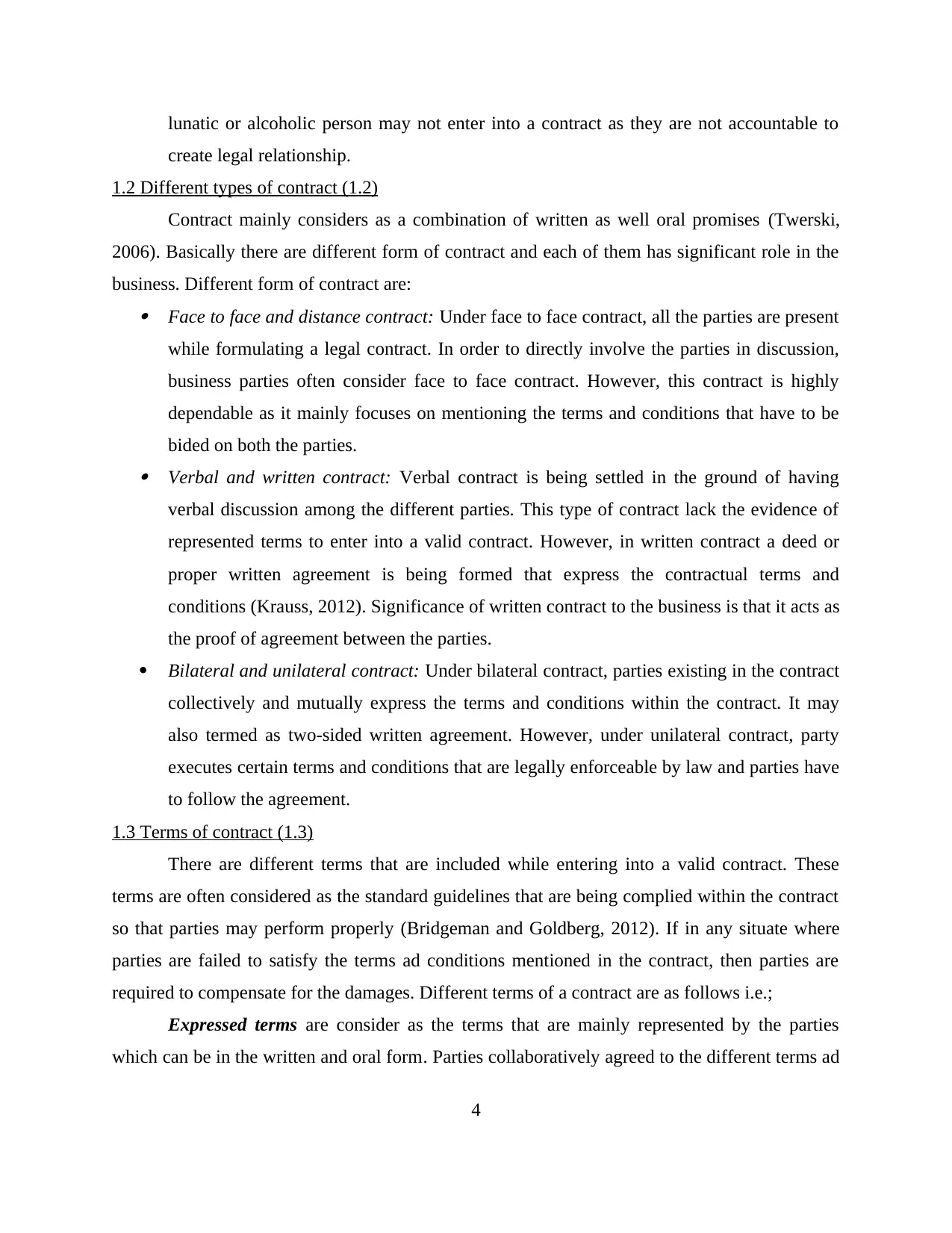
lunatic or alcoholic person may not enter into a contract as they are not accountable to
create legal relationship.
1.2 Different types of contract (1.2)
Contract mainly considers as a combination of written as well oral promises (Twerski,
2006). Basically there are different form of contract and each of them has significant role in the
business. Different form of contract are: Face to face and distance contract: Under face to face contract, all the parties are present
while formulating a legal contract. In order to directly involve the parties in discussion,
business parties often consider face to face contract. However, this contract is highly
dependable as it mainly focuses on mentioning the terms and conditions that have to be
bided on both the parties. Verbal and written contract: Verbal contract is being settled in the ground of having
verbal discussion among the different parties. This type of contract lack the evidence of
represented terms to enter into a valid contract. However, in written contract a deed or
proper written agreement is being formed that express the contractual terms and
conditions (Krauss, 2012). Significance of written contract to the business is that it acts as
the proof of agreement between the parties.
Bilateral and unilateral contract: Under bilateral contract, parties existing in the contract
collectively and mutually express the terms and conditions within the contract. It may
also termed as two-sided written agreement. However, under unilateral contract, party
executes certain terms and conditions that are legally enforceable by law and parties have
to follow the agreement.
1.3 Terms of contract (1.3)
There are different terms that are included while entering into a valid contract. These
terms are often considered as the standard guidelines that are being complied within the contract
so that parties may perform properly (Bridgeman and Goldberg, 2012). If in any situate where
parties are failed to satisfy the terms ad conditions mentioned in the contract, then parties are
required to compensate for the damages. Different terms of a contract are as follows i.e.;
Expressed terms are consider as the terms that are mainly represented by the parties
which can be in the written and oral form. Parties collaboratively agreed to the different terms ad
4
create legal relationship.
1.2 Different types of contract (1.2)
Contract mainly considers as a combination of written as well oral promises (Twerski,
2006). Basically there are different form of contract and each of them has significant role in the
business. Different form of contract are: Face to face and distance contract: Under face to face contract, all the parties are present
while formulating a legal contract. In order to directly involve the parties in discussion,
business parties often consider face to face contract. However, this contract is highly
dependable as it mainly focuses on mentioning the terms and conditions that have to be
bided on both the parties. Verbal and written contract: Verbal contract is being settled in the ground of having
verbal discussion among the different parties. This type of contract lack the evidence of
represented terms to enter into a valid contract. However, in written contract a deed or
proper written agreement is being formed that express the contractual terms and
conditions (Krauss, 2012). Significance of written contract to the business is that it acts as
the proof of agreement between the parties.
Bilateral and unilateral contract: Under bilateral contract, parties existing in the contract
collectively and mutually express the terms and conditions within the contract. It may
also termed as two-sided written agreement. However, under unilateral contract, party
executes certain terms and conditions that are legally enforceable by law and parties have
to follow the agreement.
1.3 Terms of contract (1.3)
There are different terms that are included while entering into a valid contract. These
terms are often considered as the standard guidelines that are being complied within the contract
so that parties may perform properly (Bridgeman and Goldberg, 2012). If in any situate where
parties are failed to satisfy the terms ad conditions mentioned in the contract, then parties are
required to compensate for the damages. Different terms of a contract are as follows i.e.;
Expressed terms are consider as the terms that are mainly represented by the parties
which can be in the written and oral form. Parties collaboratively agreed to the different terms ad
4
Paraphrase This Document
Need a fresh take? Get an instant paraphrase of this document with our AI Paraphraser
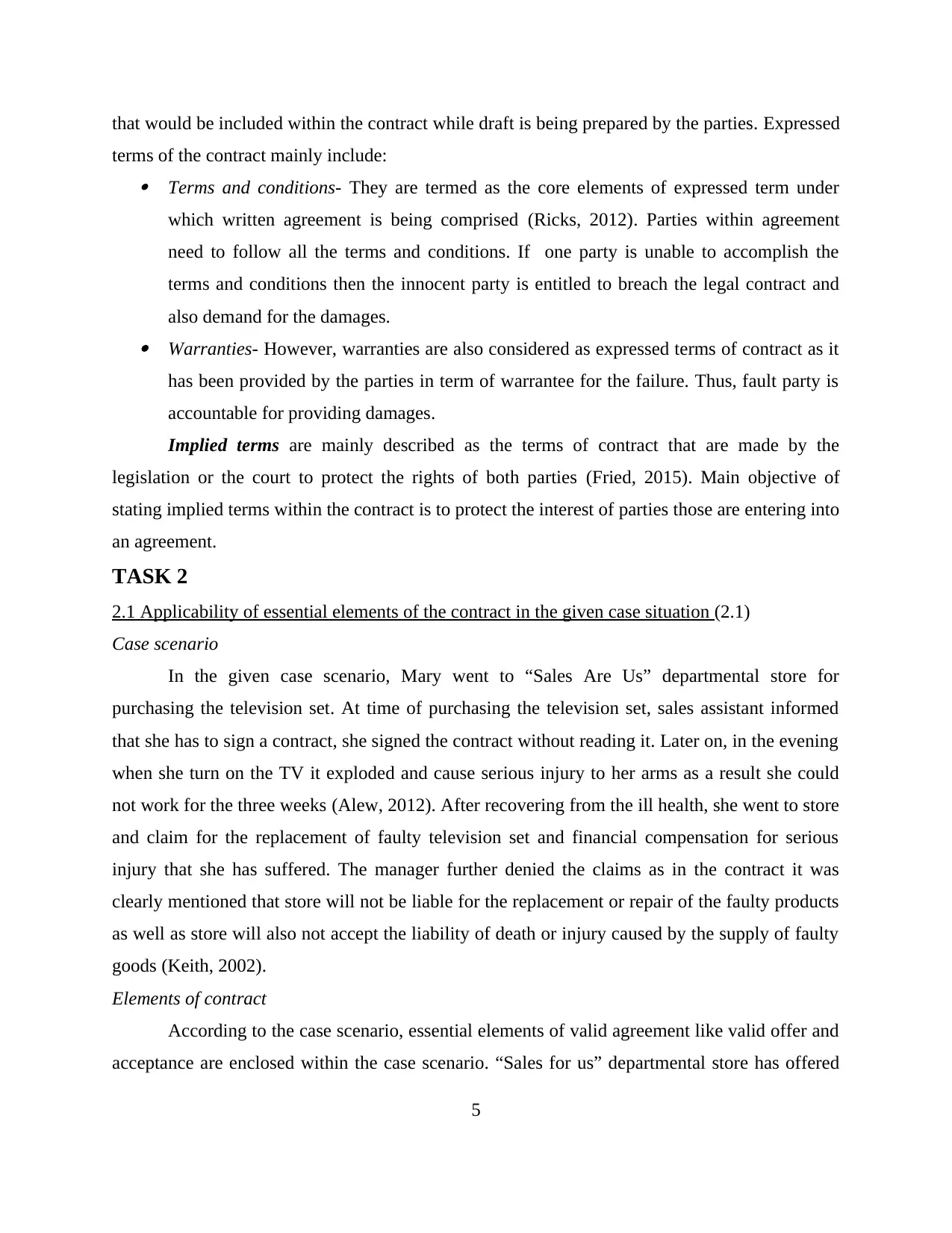
that would be included within the contract while draft is being prepared by the parties. Expressed
terms of the contract mainly include: Terms and conditions- They are termed as the core elements of expressed term under
which written agreement is being comprised (Ricks, 2012). Parties within agreement
need to follow all the terms and conditions. If one party is unable to accomplish the
terms and conditions then the innocent party is entitled to breach the legal contract and
also demand for the damages. Warranties- However, warranties are also considered as expressed terms of contract as it
has been provided by the parties in term of warrantee for the failure. Thus, fault party is
accountable for providing damages.
Implied terms are mainly described as the terms of contract that are made by the
legislation or the court to protect the rights of both parties (Fried, 2015). Main objective of
stating implied terms within the contract is to protect the interest of parties those are entering into
an agreement.
TASK 2
2.1 Applicability of essential elements of the contract in the given case situation (2.1)
Case scenario
In the given case scenario, Mary went to “Sales Are Us” departmental store for
purchasing the television set. At time of purchasing the television set, sales assistant informed
that she has to sign a contract, she signed the contract without reading it. Later on, in the evening
when she turn on the TV it exploded and cause serious injury to her arms as a result she could
not work for the three weeks (Alew, 2012). After recovering from the ill health, she went to store
and claim for the replacement of faulty television set and financial compensation for serious
injury that she has suffered. The manager further denied the claims as in the contract it was
clearly mentioned that store will not be liable for the replacement or repair of the faulty products
as well as store will also not accept the liability of death or injury caused by the supply of faulty
goods (Keith, 2002).
Elements of contract
According to the case scenario, essential elements of valid agreement like valid offer and
acceptance are enclosed within the case scenario. “Sales for us” departmental store has offered
5
terms of the contract mainly include: Terms and conditions- They are termed as the core elements of expressed term under
which written agreement is being comprised (Ricks, 2012). Parties within agreement
need to follow all the terms and conditions. If one party is unable to accomplish the
terms and conditions then the innocent party is entitled to breach the legal contract and
also demand for the damages. Warranties- However, warranties are also considered as expressed terms of contract as it
has been provided by the parties in term of warrantee for the failure. Thus, fault party is
accountable for providing damages.
Implied terms are mainly described as the terms of contract that are made by the
legislation or the court to protect the rights of both parties (Fried, 2015). Main objective of
stating implied terms within the contract is to protect the interest of parties those are entering into
an agreement.
TASK 2
2.1 Applicability of essential elements of the contract in the given case situation (2.1)
Case scenario
In the given case scenario, Mary went to “Sales Are Us” departmental store for
purchasing the television set. At time of purchasing the television set, sales assistant informed
that she has to sign a contract, she signed the contract without reading it. Later on, in the evening
when she turn on the TV it exploded and cause serious injury to her arms as a result she could
not work for the three weeks (Alew, 2012). After recovering from the ill health, she went to store
and claim for the replacement of faulty television set and financial compensation for serious
injury that she has suffered. The manager further denied the claims as in the contract it was
clearly mentioned that store will not be liable for the replacement or repair of the faulty products
as well as store will also not accept the liability of death or injury caused by the supply of faulty
goods (Keith, 2002).
Elements of contract
According to the case scenario, essential elements of valid agreement like valid offer and
acceptance are enclosed within the case scenario. “Sales for us” departmental store has offered
5
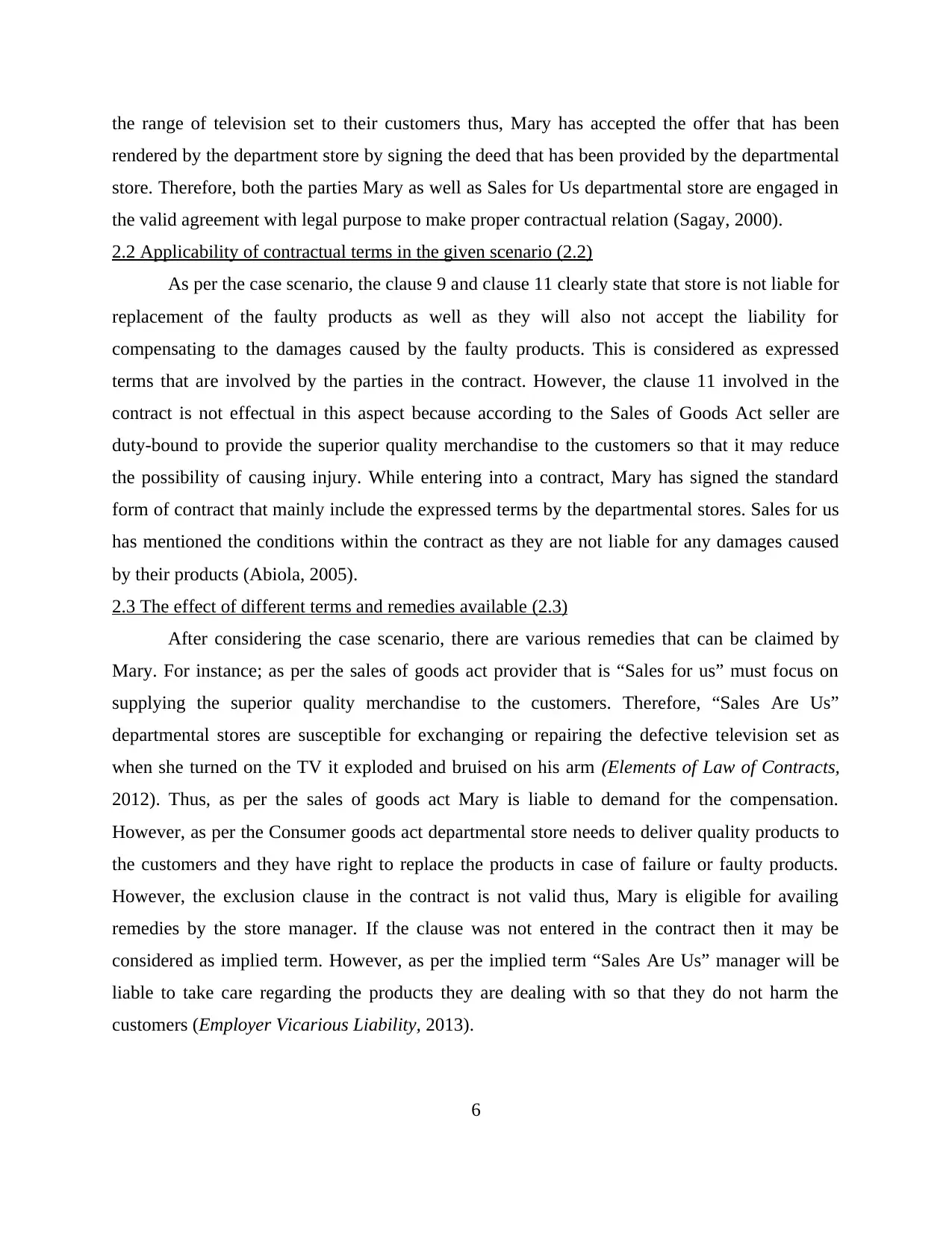
the range of television set to their customers thus, Mary has accepted the offer that has been
rendered by the department store by signing the deed that has been provided by the departmental
store. Therefore, both the parties Mary as well as Sales for Us departmental store are engaged in
the valid agreement with legal purpose to make proper contractual relation (Sagay, 2000).
2.2 Applicability of contractual terms in the given scenario (2.2)
As per the case scenario, the clause 9 and clause 11 clearly state that store is not liable for
replacement of the faulty products as well as they will also not accept the liability for
compensating to the damages caused by the faulty products. This is considered as expressed
terms that are involved by the parties in the contract. However, the clause 11 involved in the
contract is not effectual in this aspect because according to the Sales of Goods Act seller are
duty-bound to provide the superior quality merchandise to the customers so that it may reduce
the possibility of causing injury. While entering into a contract, Mary has signed the standard
form of contract that mainly include the expressed terms by the departmental stores. Sales for us
has mentioned the conditions within the contract as they are not liable for any damages caused
by their products (Abiola, 2005).
2.3 The effect of different terms and remedies available (2.3)
After considering the case scenario, there are various remedies that can be claimed by
Mary. For instance; as per the sales of goods act provider that is “Sales for us” must focus on
supplying the superior quality merchandise to the customers. Therefore, “Sales Are Us”
departmental stores are susceptible for exchanging or repairing the defective television set as
when she turned on the TV it exploded and bruised on his arm (Elements of Law of Contracts,
2012). Thus, as per the sales of goods act Mary is liable to demand for the compensation.
However, as per the Consumer goods act departmental store needs to deliver quality products to
the customers and they have right to replace the products in case of failure or faulty products.
However, the exclusion clause in the contract is not valid thus, Mary is eligible for availing
remedies by the store manager. If the clause was not entered in the contract then it may be
considered as implied term. However, as per the implied term “Sales Are Us” manager will be
liable to take care regarding the products they are dealing with so that they do not harm the
customers (Employer Vicarious Liability, 2013).
6
rendered by the department store by signing the deed that has been provided by the departmental
store. Therefore, both the parties Mary as well as Sales for Us departmental store are engaged in
the valid agreement with legal purpose to make proper contractual relation (Sagay, 2000).
2.2 Applicability of contractual terms in the given scenario (2.2)
As per the case scenario, the clause 9 and clause 11 clearly state that store is not liable for
replacement of the faulty products as well as they will also not accept the liability for
compensating to the damages caused by the faulty products. This is considered as expressed
terms that are involved by the parties in the contract. However, the clause 11 involved in the
contract is not effectual in this aspect because according to the Sales of Goods Act seller are
duty-bound to provide the superior quality merchandise to the customers so that it may reduce
the possibility of causing injury. While entering into a contract, Mary has signed the standard
form of contract that mainly include the expressed terms by the departmental stores. Sales for us
has mentioned the conditions within the contract as they are not liable for any damages caused
by their products (Abiola, 2005).
2.3 The effect of different terms and remedies available (2.3)
After considering the case scenario, there are various remedies that can be claimed by
Mary. For instance; as per the sales of goods act provider that is “Sales for us” must focus on
supplying the superior quality merchandise to the customers. Therefore, “Sales Are Us”
departmental stores are susceptible for exchanging or repairing the defective television set as
when she turned on the TV it exploded and bruised on his arm (Elements of Law of Contracts,
2012). Thus, as per the sales of goods act Mary is liable to demand for the compensation.
However, as per the Consumer goods act departmental store needs to deliver quality products to
the customers and they have right to replace the products in case of failure or faulty products.
However, the exclusion clause in the contract is not valid thus, Mary is eligible for availing
remedies by the store manager. If the clause was not entered in the contract then it may be
considered as implied term. However, as per the implied term “Sales Are Us” manager will be
liable to take care regarding the products they are dealing with so that they do not harm the
customers (Employer Vicarious Liability, 2013).
6
⊘ This is a preview!⊘
Do you want full access?
Subscribe today to unlock all pages.

Trusted by 1+ million students worldwide
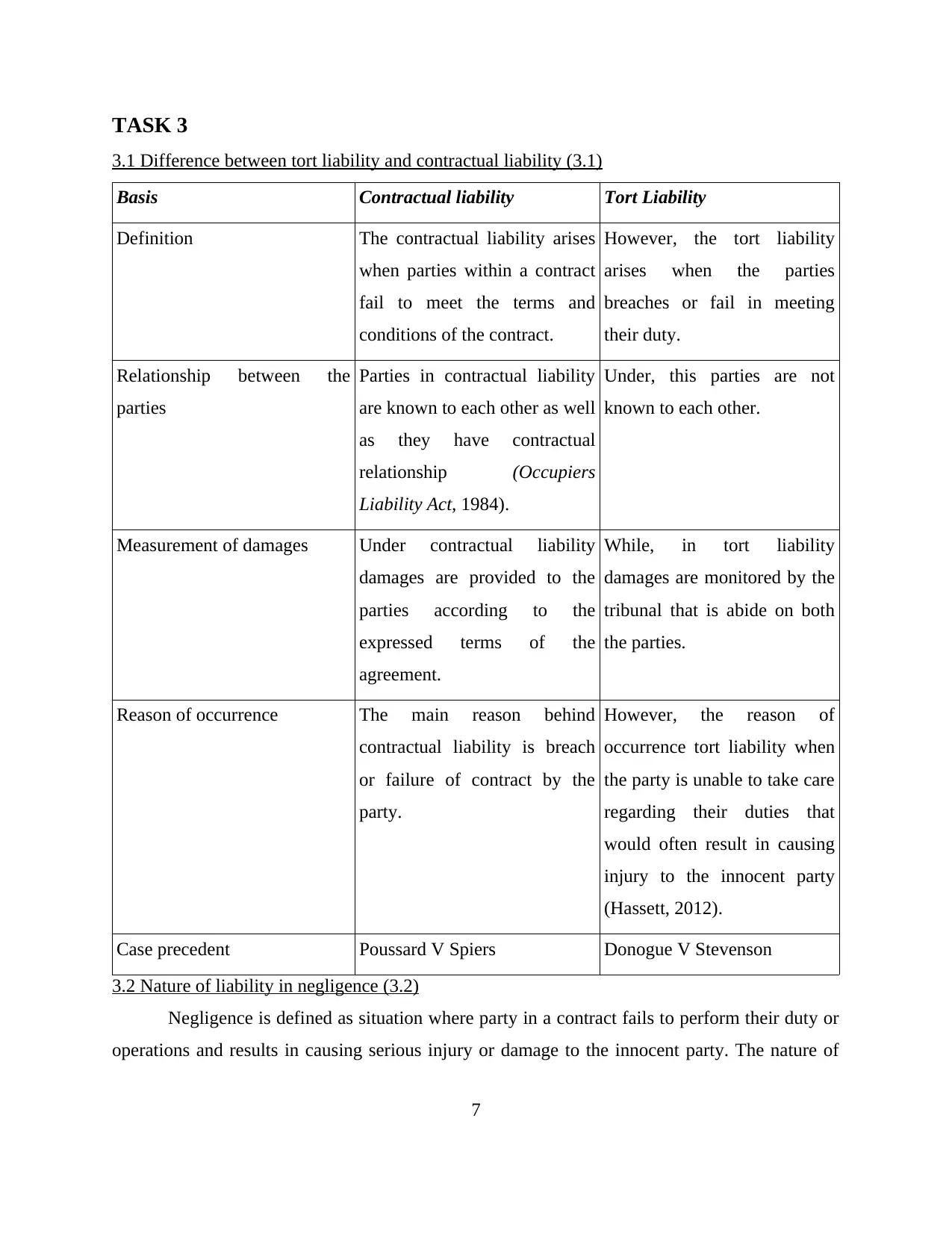
TASK 3
3.1 Difference between tort liability and contractual liability (3.1)
Basis Contractual liability Tort Liability
Definition The contractual liability arises
when parties within a contract
fail to meet the terms and
conditions of the contract.
However, the tort liability
arises when the parties
breaches or fail in meeting
their duty.
Relationship between the
parties
Parties in contractual liability
are known to each other as well
as they have contractual
relationship (Occupiers
Liability Act, 1984).
Under, this parties are not
known to each other.
Measurement of damages Under contractual liability
damages are provided to the
parties according to the
expressed terms of the
agreement.
While, in tort liability
damages are monitored by the
tribunal that is abide on both
the parties.
Reason of occurrence The main reason behind
contractual liability is breach
or failure of contract by the
party.
However, the reason of
occurrence tort liability when
the party is unable to take care
regarding their duties that
would often result in causing
injury to the innocent party
(Hassett, 2012).
Case precedent Poussard V Spiers Donogue V Stevenson
3.2 Nature of liability in negligence (3.2)
Negligence is defined as situation where party in a contract fails to perform their duty or
operations and results in causing serious injury or damage to the innocent party. The nature of
7
3.1 Difference between tort liability and contractual liability (3.1)
Basis Contractual liability Tort Liability
Definition The contractual liability arises
when parties within a contract
fail to meet the terms and
conditions of the contract.
However, the tort liability
arises when the parties
breaches or fail in meeting
their duty.
Relationship between the
parties
Parties in contractual liability
are known to each other as well
as they have contractual
relationship (Occupiers
Liability Act, 1984).
Under, this parties are not
known to each other.
Measurement of damages Under contractual liability
damages are provided to the
parties according to the
expressed terms of the
agreement.
While, in tort liability
damages are monitored by the
tribunal that is abide on both
the parties.
Reason of occurrence The main reason behind
contractual liability is breach
or failure of contract by the
party.
However, the reason of
occurrence tort liability when
the party is unable to take care
regarding their duties that
would often result in causing
injury to the innocent party
(Hassett, 2012).
Case precedent Poussard V Spiers Donogue V Stevenson
3.2 Nature of liability in negligence (3.2)
Negligence is defined as situation where party in a contract fails to perform their duty or
operations and results in causing serious injury or damage to the innocent party. The nature of
7
Paraphrase This Document
Need a fresh take? Get an instant paraphrase of this document with our AI Paraphraser
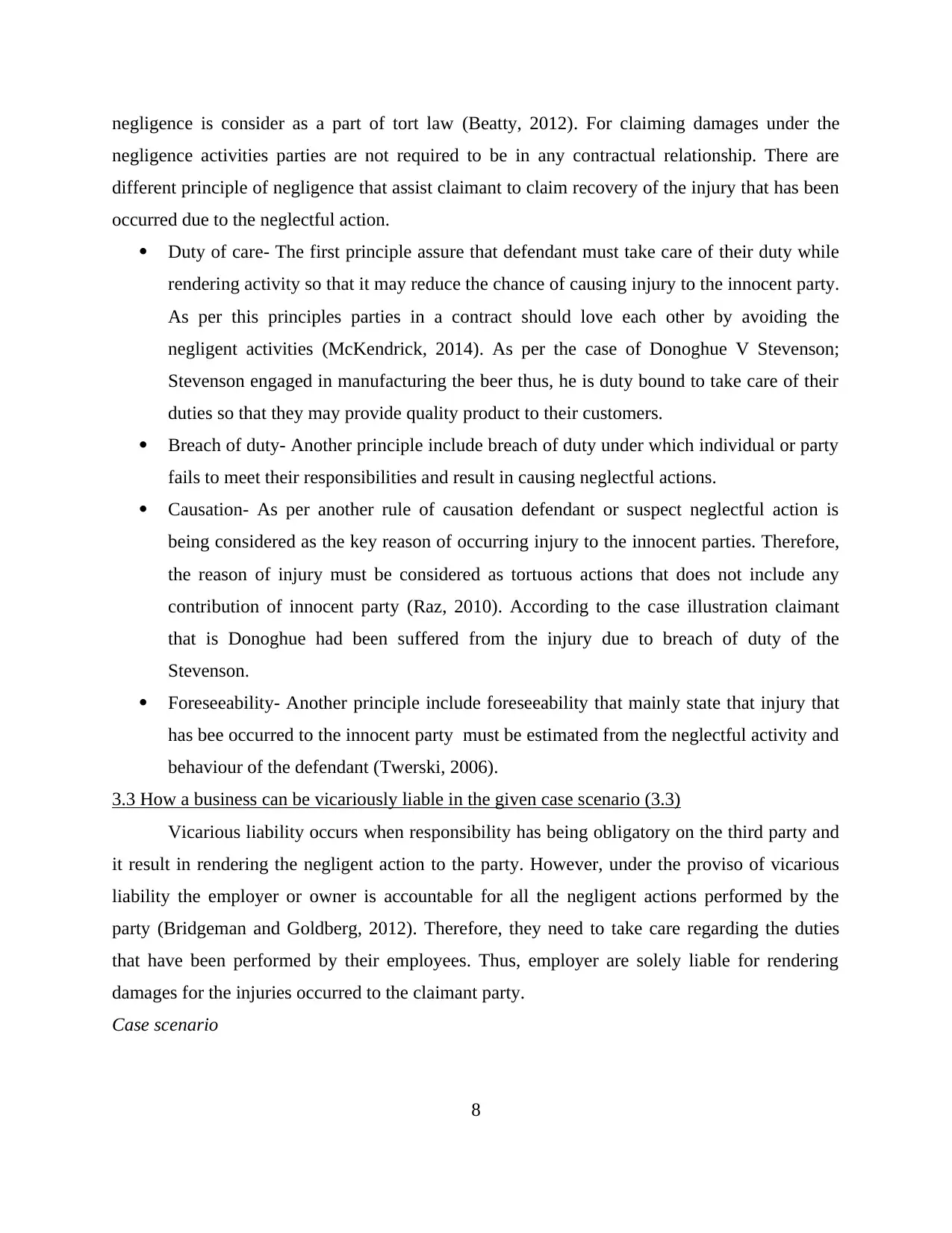
negligence is consider as a part of tort law (Beatty, 2012). For claiming damages under the
negligence activities parties are not required to be in any contractual relationship. There are
different principle of negligence that assist claimant to claim recovery of the injury that has been
occurred due to the neglectful action.
Duty of care- The first principle assure that defendant must take care of their duty while
rendering activity so that it may reduce the chance of causing injury to the innocent party.
As per this principles parties in a contract should love each other by avoiding the
negligent activities (McKendrick, 2014). As per the case of Donoghue V Stevenson;
Stevenson engaged in manufacturing the beer thus, he is duty bound to take care of their
duties so that they may provide quality product to their customers.
Breach of duty- Another principle include breach of duty under which individual or party
fails to meet their responsibilities and result in causing neglectful actions.
Causation- As per another rule of causation defendant or suspect neglectful action is
being considered as the key reason of occurring injury to the innocent parties. Therefore,
the reason of injury must be considered as tortuous actions that does not include any
contribution of innocent party (Raz, 2010). According to the case illustration claimant
that is Donoghue had been suffered from the injury due to breach of duty of the
Stevenson.
Foreseeability- Another principle include foreseeability that mainly state that injury that
has bee occurred to the innocent party must be estimated from the neglectful activity and
behaviour of the defendant (Twerski, 2006).
3.3 How a business can be vicariously liable in the given case scenario (3.3)
Vicarious liability occurs when responsibility has being obligatory on the third party and
it result in rendering the negligent action to the party. However, under the proviso of vicarious
liability the employer or owner is accountable for all the negligent actions performed by the
party (Bridgeman and Goldberg, 2012). Therefore, they need to take care regarding the duties
that have been performed by their employees. Thus, employer are solely liable for rendering
damages for the injuries occurred to the claimant party.
Case scenario
8
negligence activities parties are not required to be in any contractual relationship. There are
different principle of negligence that assist claimant to claim recovery of the injury that has been
occurred due to the neglectful action.
Duty of care- The first principle assure that defendant must take care of their duty while
rendering activity so that it may reduce the chance of causing injury to the innocent party.
As per this principles parties in a contract should love each other by avoiding the
negligent activities (McKendrick, 2014). As per the case of Donoghue V Stevenson;
Stevenson engaged in manufacturing the beer thus, he is duty bound to take care of their
duties so that they may provide quality product to their customers.
Breach of duty- Another principle include breach of duty under which individual or party
fails to meet their responsibilities and result in causing neglectful actions.
Causation- As per another rule of causation defendant or suspect neglectful action is
being considered as the key reason of occurring injury to the innocent parties. Therefore,
the reason of injury must be considered as tortuous actions that does not include any
contribution of innocent party (Raz, 2010). According to the case illustration claimant
that is Donoghue had been suffered from the injury due to breach of duty of the
Stevenson.
Foreseeability- Another principle include foreseeability that mainly state that injury that
has bee occurred to the innocent party must be estimated from the neglectful activity and
behaviour of the defendant (Twerski, 2006).
3.3 How a business can be vicariously liable in the given case scenario (3.3)
Vicarious liability occurs when responsibility has being obligatory on the third party and
it result in rendering the negligent action to the party. However, under the proviso of vicarious
liability the employer or owner is accountable for all the negligent actions performed by the
party (Bridgeman and Goldberg, 2012). Therefore, they need to take care regarding the duties
that have been performed by their employees. Thus, employer are solely liable for rendering
damages for the injuries occurred to the claimant party.
Case scenario
8
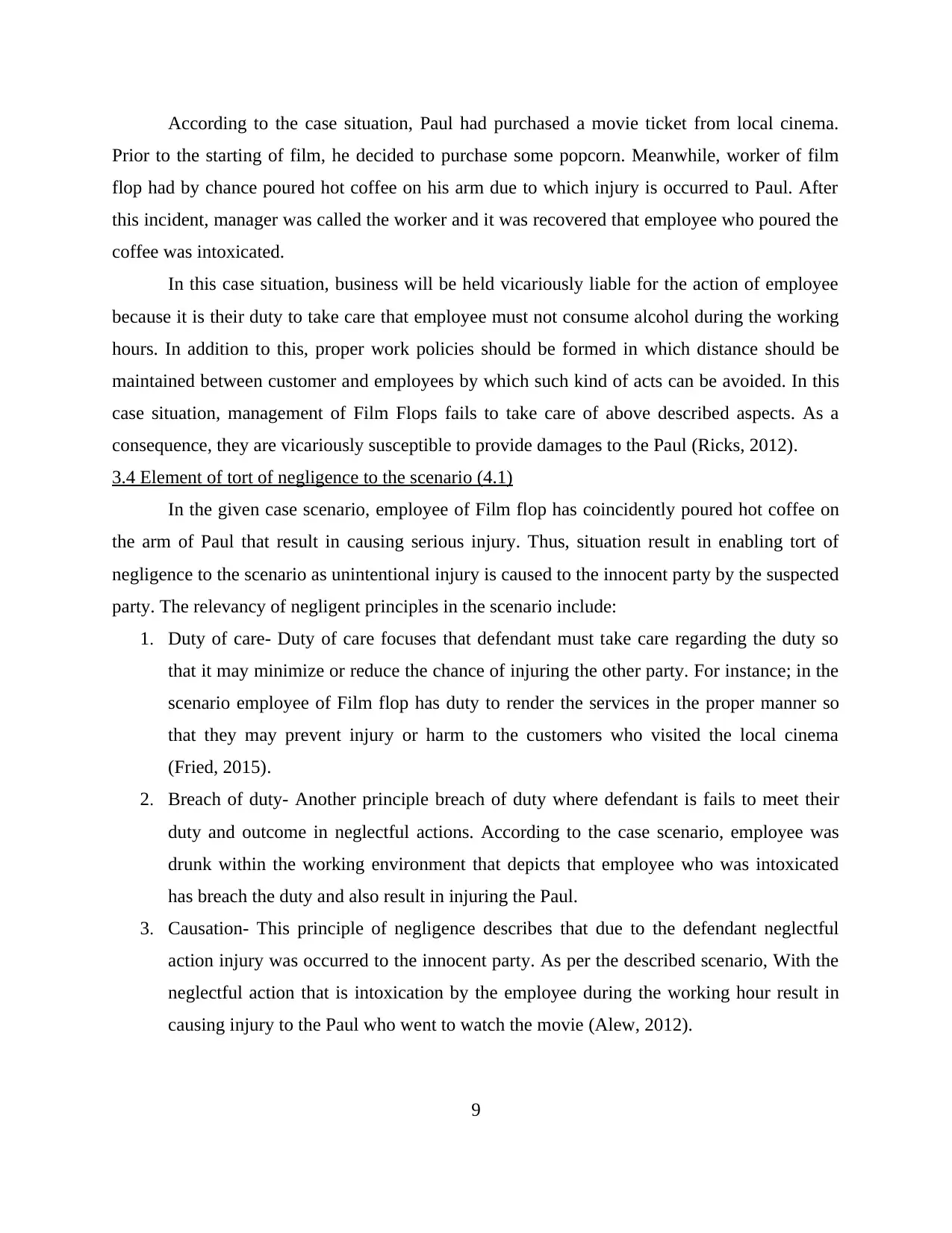
According to the case situation, Paul had purchased a movie ticket from local cinema.
Prior to the starting of film, he decided to purchase some popcorn. Meanwhile, worker of film
flop had by chance poured hot coffee on his arm due to which injury is occurred to Paul. After
this incident, manager was called the worker and it was recovered that employee who poured the
coffee was intoxicated.
In this case situation, business will be held vicariously liable for the action of employee
because it is their duty to take care that employee must not consume alcohol during the working
hours. In addition to this, proper work policies should be formed in which distance should be
maintained between customer and employees by which such kind of acts can be avoided. In this
case situation, management of Film Flops fails to take care of above described aspects. As a
consequence, they are vicariously susceptible to provide damages to the Paul (Ricks, 2012).
3.4 Element of tort of negligence to the scenario (4.1)
In the given case scenario, employee of Film flop has coincidently poured hot coffee on
the arm of Paul that result in causing serious injury. Thus, situation result in enabling tort of
negligence to the scenario as unintentional injury is caused to the innocent party by the suspected
party. The relevancy of negligent principles in the scenario include:
1. Duty of care- Duty of care focuses that defendant must take care regarding the duty so
that it may minimize or reduce the chance of injuring the other party. For instance; in the
scenario employee of Film flop has duty to render the services in the proper manner so
that they may prevent injury or harm to the customers who visited the local cinema
(Fried, 2015).
2. Breach of duty- Another principle breach of duty where defendant is fails to meet their
duty and outcome in neglectful actions. According to the case scenario, employee was
drunk within the working environment that depicts that employee who was intoxicated
has breach the duty and also result in injuring the Paul.
3. Causation- This principle of negligence describes that due to the defendant neglectful
action injury was occurred to the innocent party. As per the described scenario, With the
neglectful action that is intoxication by the employee during the working hour result in
causing injury to the Paul who went to watch the movie (Alew, 2012).
9
Prior to the starting of film, he decided to purchase some popcorn. Meanwhile, worker of film
flop had by chance poured hot coffee on his arm due to which injury is occurred to Paul. After
this incident, manager was called the worker and it was recovered that employee who poured the
coffee was intoxicated.
In this case situation, business will be held vicariously liable for the action of employee
because it is their duty to take care that employee must not consume alcohol during the working
hours. In addition to this, proper work policies should be formed in which distance should be
maintained between customer and employees by which such kind of acts can be avoided. In this
case situation, management of Film Flops fails to take care of above described aspects. As a
consequence, they are vicariously susceptible to provide damages to the Paul (Ricks, 2012).
3.4 Element of tort of negligence to the scenario (4.1)
In the given case scenario, employee of Film flop has coincidently poured hot coffee on
the arm of Paul that result in causing serious injury. Thus, situation result in enabling tort of
negligence to the scenario as unintentional injury is caused to the innocent party by the suspected
party. The relevancy of negligent principles in the scenario include:
1. Duty of care- Duty of care focuses that defendant must take care regarding the duty so
that it may minimize or reduce the chance of injuring the other party. For instance; in the
scenario employee of Film flop has duty to render the services in the proper manner so
that they may prevent injury or harm to the customers who visited the local cinema
(Fried, 2015).
2. Breach of duty- Another principle breach of duty where defendant is fails to meet their
duty and outcome in neglectful actions. According to the case scenario, employee was
drunk within the working environment that depicts that employee who was intoxicated
has breach the duty and also result in injuring the Paul.
3. Causation- This principle of negligence describes that due to the defendant neglectful
action injury was occurred to the innocent party. As per the described scenario, With the
neglectful action that is intoxication by the employee during the working hour result in
causing injury to the Paul who went to watch the movie (Alew, 2012).
9
⊘ This is a preview!⊘
Do you want full access?
Subscribe today to unlock all pages.

Trusted by 1+ million students worldwide
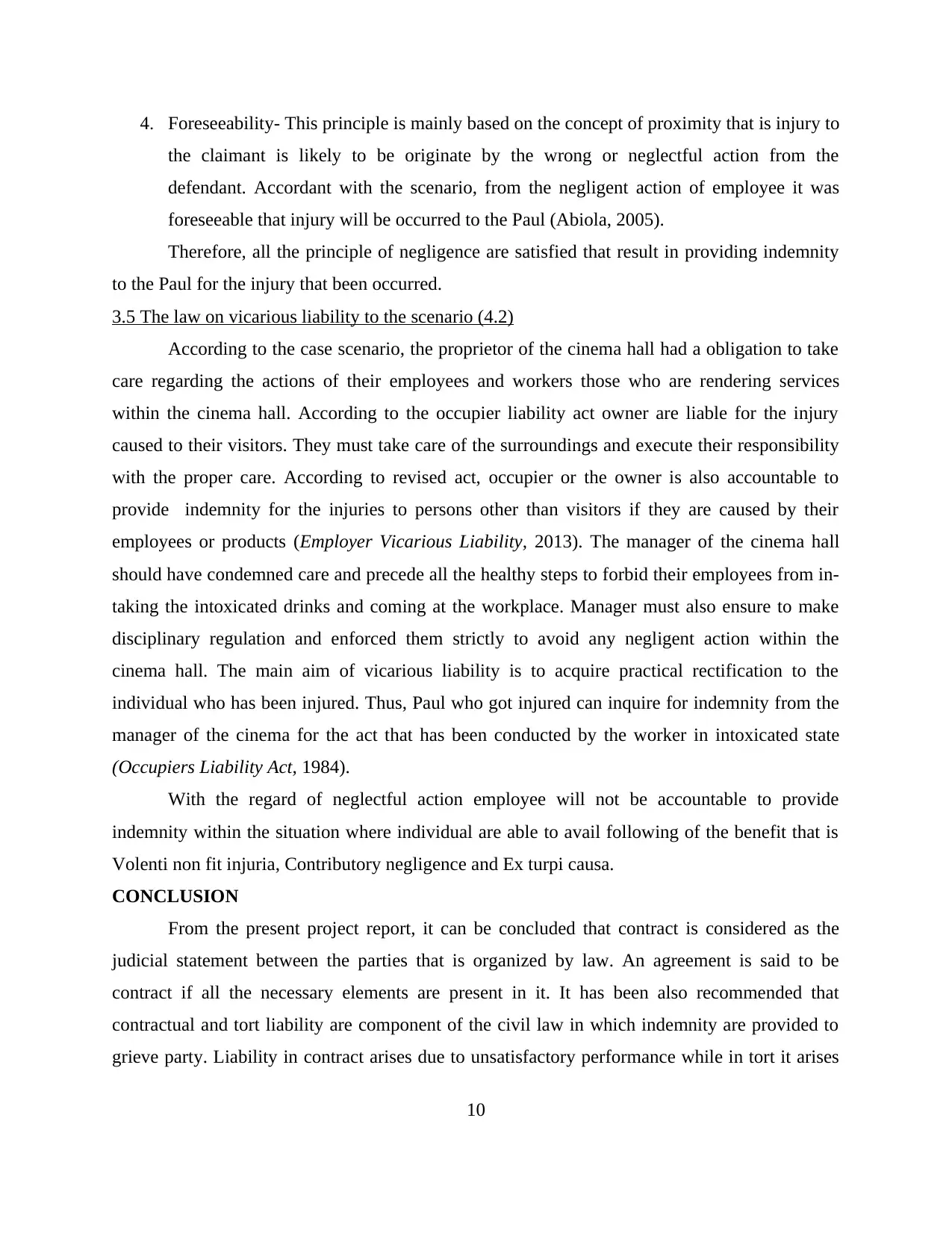
4. Foreseeability- This principle is mainly based on the concept of proximity that is injury to
the claimant is likely to be originate by the wrong or neglectful action from the
defendant. Accordant with the scenario, from the negligent action of employee it was
foreseeable that injury will be occurred to the Paul (Abiola, 2005).
Therefore, all the principle of negligence are satisfied that result in providing indemnity
to the Paul for the injury that been occurred.
3.5 The law on vicarious liability to the scenario (4.2)
According to the case scenario, the proprietor of the cinema hall had a obligation to take
care regarding the actions of their employees and workers those who are rendering services
within the cinema hall. According to the occupier liability act owner are liable for the injury
caused to their visitors. They must take care of the surroundings and execute their responsibility
with the proper care. According to revised act, occupier or the owner is also accountable to
provide indemnity for the injuries to persons other than visitors if they are caused by their
employees or products (Employer Vicarious Liability, 2013). The manager of the cinema hall
should have condemned care and precede all the healthy steps to forbid their employees from in-
taking the intoxicated drinks and coming at the workplace. Manager must also ensure to make
disciplinary regulation and enforced them strictly to avoid any negligent action within the
cinema hall. The main aim of vicarious liability is to acquire practical rectification to the
individual who has been injured. Thus, Paul who got injured can inquire for indemnity from the
manager of the cinema for the act that has been conducted by the worker in intoxicated state
(Occupiers Liability Act, 1984).
With the regard of neglectful action employee will not be accountable to provide
indemnity within the situation where individual are able to avail following of the benefit that is
Volenti non fit injuria, Contributory negligence and Ex turpi causa.
CONCLUSION
From the present project report, it can be concluded that contract is considered as the
judicial statement between the parties that is organized by law. An agreement is said to be
contract if all the necessary elements are present in it. It has been also recommended that
contractual and tort liability are component of the civil law in which indemnity are provided to
grieve party. Liability in contract arises due to unsatisfactory performance while in tort it arises
10
the claimant is likely to be originate by the wrong or neglectful action from the
defendant. Accordant with the scenario, from the negligent action of employee it was
foreseeable that injury will be occurred to the Paul (Abiola, 2005).
Therefore, all the principle of negligence are satisfied that result in providing indemnity
to the Paul for the injury that been occurred.
3.5 The law on vicarious liability to the scenario (4.2)
According to the case scenario, the proprietor of the cinema hall had a obligation to take
care regarding the actions of their employees and workers those who are rendering services
within the cinema hall. According to the occupier liability act owner are liable for the injury
caused to their visitors. They must take care of the surroundings and execute their responsibility
with the proper care. According to revised act, occupier or the owner is also accountable to
provide indemnity for the injuries to persons other than visitors if they are caused by their
employees or products (Employer Vicarious Liability, 2013). The manager of the cinema hall
should have condemned care and precede all the healthy steps to forbid their employees from in-
taking the intoxicated drinks and coming at the workplace. Manager must also ensure to make
disciplinary regulation and enforced them strictly to avoid any negligent action within the
cinema hall. The main aim of vicarious liability is to acquire practical rectification to the
individual who has been injured. Thus, Paul who got injured can inquire for indemnity from the
manager of the cinema for the act that has been conducted by the worker in intoxicated state
(Occupiers Liability Act, 1984).
With the regard of neglectful action employee will not be accountable to provide
indemnity within the situation where individual are able to avail following of the benefit that is
Volenti non fit injuria, Contributory negligence and Ex turpi causa.
CONCLUSION
From the present project report, it can be concluded that contract is considered as the
judicial statement between the parties that is organized by law. An agreement is said to be
contract if all the necessary elements are present in it. It has been also recommended that
contractual and tort liability are component of the civil law in which indemnity are provided to
grieve party. Liability in contract arises due to unsatisfactory performance while in tort it arises
10
Paraphrase This Document
Need a fresh take? Get an instant paraphrase of this document with our AI Paraphraser
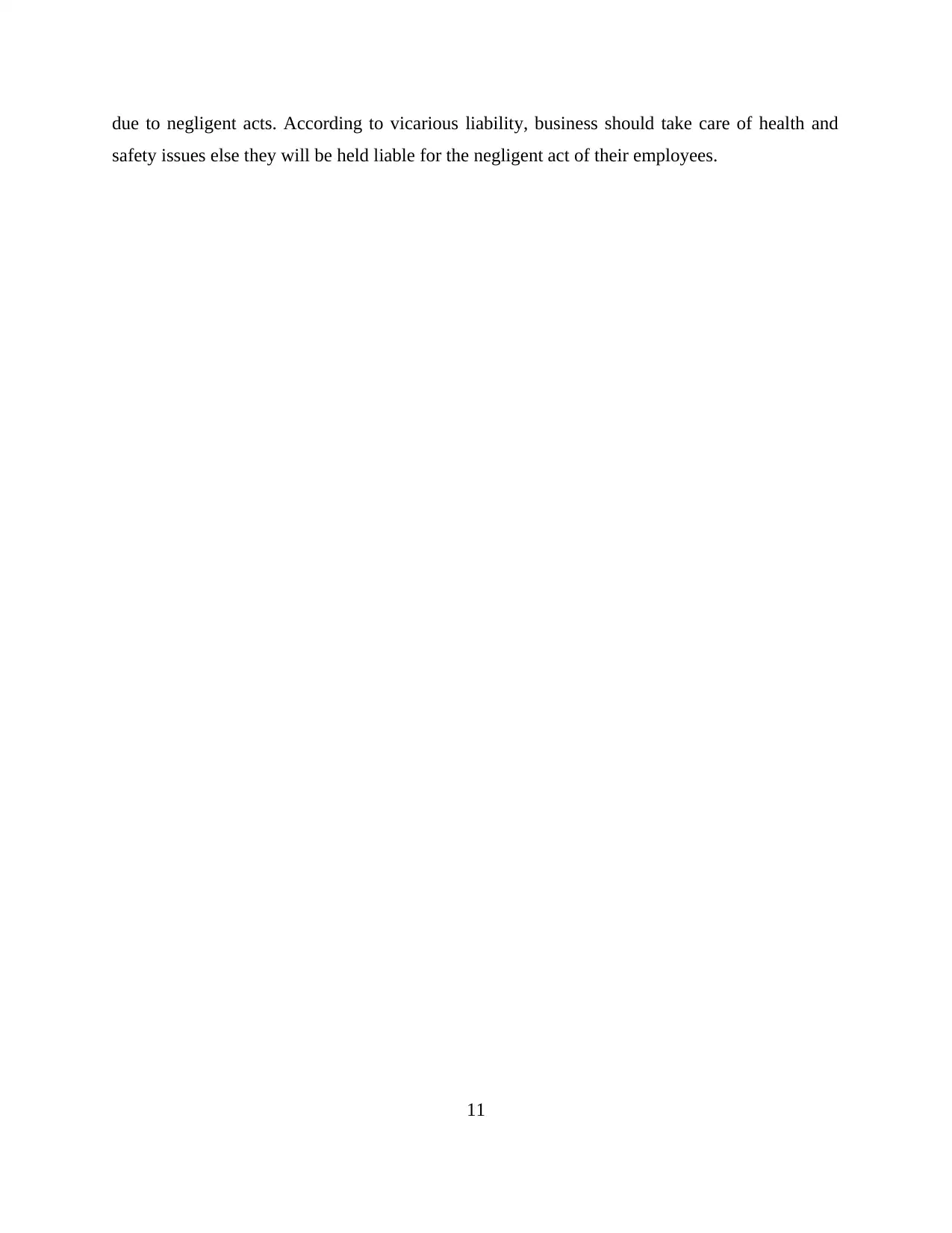
due to negligent acts. According to vicarious liability, business should take care of health and
safety issues else they will be held liable for the negligent act of their employees.
11
safety issues else they will be held liable for the negligent act of their employees.
11
1 out of 11
Related Documents
Your All-in-One AI-Powered Toolkit for Academic Success.
+13062052269
info@desklib.com
Available 24*7 on WhatsApp / Email
![[object Object]](/_next/static/media/star-bottom.7253800d.svg)
Unlock your academic potential
Copyright © 2020–2025 A2Z Services. All Rights Reserved. Developed and managed by ZUCOL.





